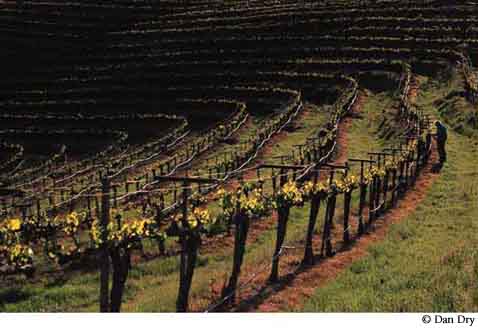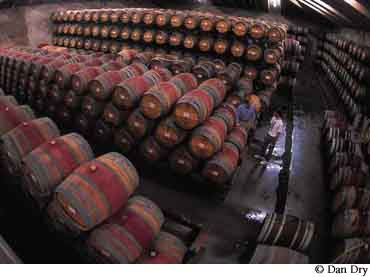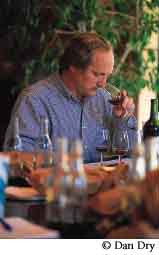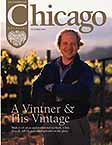The University of Chicago Magazine
October 1997


Getting the wine into the bottle is no easy matter, either. The land and the grapes demand a year-in, year-out cycle.
"The beauty of winemaking and grapegrowing is that every year you go through a lot of the same steps," Howell says. "It almost becomes like a ritual."
In the vineyard, after the September or October harvest-a bit later in the mountains than in the valley-Howell and the vineyard crew must start preparing for winter storms, whose rains increase the threat of erosion to the terraced hillside land. January through March are spent pruning the vines, which are planted in scattered sites. Spring brings "bud break," after which the vines require watering, pest protection, and exposure to sun as the grapes ripen throughout the summer.
Then, as pressure in the vineyard eases, Howell and the staff turn their attention to cleaning and adjusting equipment in preparation for the coming harvest.
The cellar, of course, has its own ritual. Once they have been handpicked, the grapes must be destemmed within the day and put into tanks to be vinified-initially creating as many as two dozen lots of wine. Each lot's distinct flavor is influenced not only by varietal, but by where in the vineyard the grapes were grown.
Those lots eventually become the three wines
that Cain bottles and sells, each of which follows its own cycle through
the cellar. The Cain Five's cycle is the longest and most complex.  After two to four weeks in the tanks, the lots go into
oak barrels, where they stay for the next 18 to 22 months. For the first
several months, the Cain staff tastes the lots regularly. Then they blend
the lots to make the Cain Five and the Cain Cuvée, selling the wines
they choose not to use in bulk to other wineries. Back in barrels, the blends
are racked, or decanted, every three months for clarification and aeration.
After two to four weeks in the tanks, the lots go into
oak barrels, where they stay for the next 18 to 22 months. For the first
several months, the Cain staff tastes the lots regularly. Then they blend
the lots to make the Cain Five and the Cain Cuvée, selling the wines
they choose not to use in bulk to other wineries. Back in barrels, the blends
are racked, or decanted, every three months for clarification and aeration.
Nearly two years after a harvest, the Cain Five made from that vintage will be bottled, but not labeled. "Because it's Cain Five, and that's my baby, we don't put the labels on," Howell says. "We're going to look at it again in six months. If it looks perfect, we'll stick the label on." Even then, the final product won't be released until Howell thinks it's ready; the 1993 Cain Five was just released this past April.
Though Howell has the final word on when to
pick the fruit, how long to macerate it, and which lots to blend, he emphasizes
that winemaking is "always, always a team process." Tasting, in
particular, is done as a group. "You can't use a single opinion, you
need to do it more than once, you need to work together collectively,"
he says. "Each day, each person perceives a wine slightly differently."
With the vineyard's signature Cain Five, he strives for general ideals: Aromatic complexity. The absence of flaws, such as a vegetable smell. A smooth entry that builds in weight and volume. Suppleness. Body. A balance between astringency, acidity, and sweetness.
"The 'in' word in descriptors today is 'jammy,' that cooked-fruit flavor," he says. Cain Five, in contrast, "doesn't have that full-on cooked-fruit flavor that everybody loves so much." Instead, "it has really deep, intense, complex flavors."
So far, Howell says the 1991 Cain Five (sold out since 1995, the year it was re-leased) is his favorite of the wines he's made, followed by the 1994 Cain Five, to be released in 1998. But Howell himself is reluctant to call any wine "his." Even a group of people can't take credit for a wine, he notes, because the land plays a significant role, as well.
"Somehow this fruit expresses through the wine something of where it came from," says Howell, sitting with his empty cup of morning coffee in the dining room.
That doesn't mean that a wine's impact is entirely rooted in its provenance, he contends. It also reflects one's experience in drinking it-the friends, the food, the weather. "I like the fact that it's always going to be different and you don't have that control," Howell muses contentedly. "In a way I chose my profession because there is no great pretension about it. I just knew people would drink the wine and it would be gone and that would be that. It's not like building monuments. You can go look at Roman ruins, you can look at pyramids, but you can never taste their wine. I like that ephemeral aspect."
Visit Cain
Vineyard & Winery's website
Other Features:
Once & future scenes
America's first professional ecologist was a U of C botanist whose thousands
of lantern slides--used to give students a tour of the nation's evolving
landscapes--will reach new viewers via the internet.
MARY RUTH YOE
Jumping into the
culture wars
A new master's program in the humanities takes as it's subject the big questions--and
the heated battles those questions often start.
JENNY ADAMS
